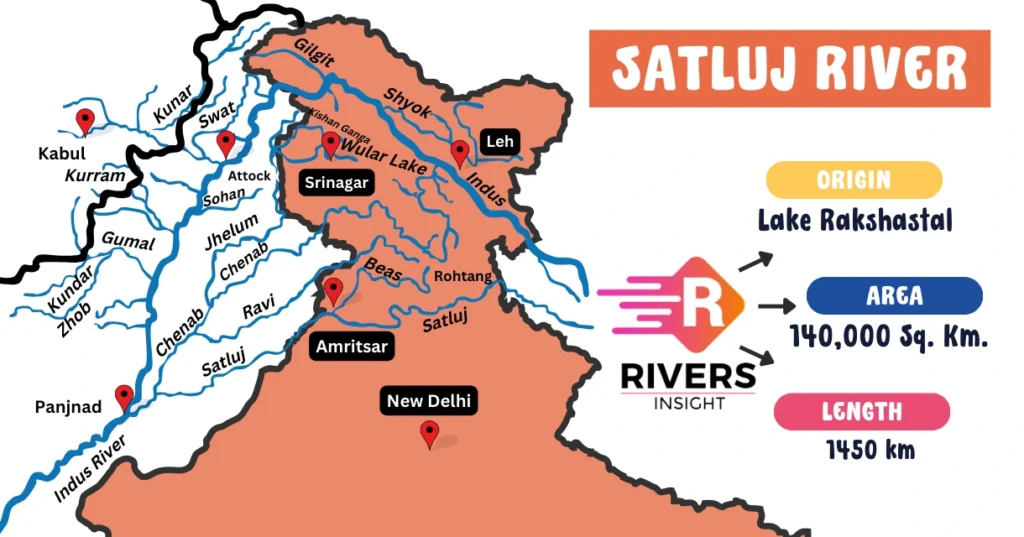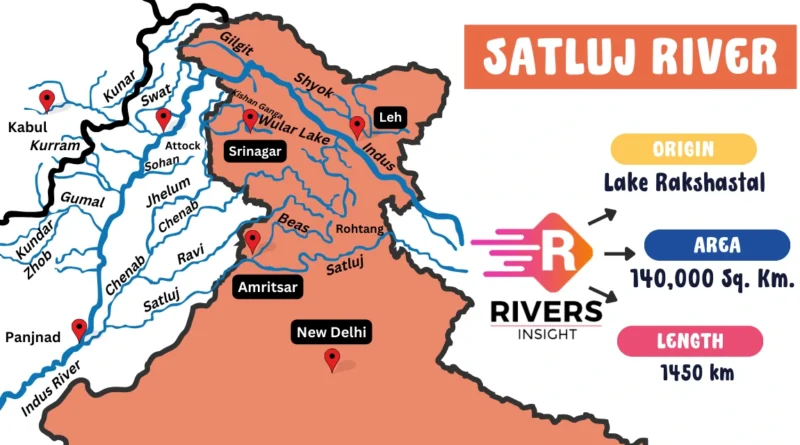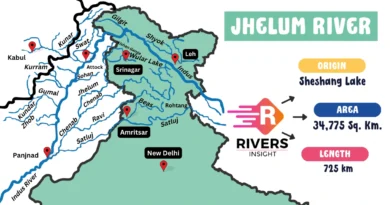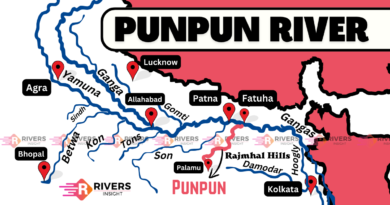Satluj River: Map & Origin with Tributaries
Table of Contents
The Satluj River, coursing through South Asia, notably China, India, Nepal, and Pakistan, has been a pivotal force in shaping the history, culture, and economy of the region. Stretching approximately 1,450 kilometers, this river flows through key Indian states such as Himachal Pradesh, Punjab, and Haryana before culminating in the Arabian Sea.
| River | Satluj |
| Length | 1450 km |
| Origin | Tibet |
| Tributary of | Indus River |
| Dams | Bhakra, Nangal, etc. |
This article provides a detailed exploration of its geographical features, including prominent dams, crucial tributaries, overall length, origin, and more.
Geographical Features of Satluj River
Origin and Course
The Satluj River originates in the Tibet Autonomous Region of China, near Lake Rakshastal. It flows through the Indian state of Himachal Pradesh before entering the Punjab region. The river then continues its course through the states of Haryana and Rajasthan before eventually emptying into the Arabian Sea. The east-to-west flow of the Satluj is distinctive, connecting the Himalayan region with the rest of India.
Length
The Satluj River ranks among the longest rivers in India, with a total length of around 1,450 kilometers. This extensive stretch plays a pivotal role in influencing the lives of millions of people residing along its course.
Tributaries
Major tributaries of the Satluj include:
- Beas
- Spiti
- Rupi
- Sutlej Yamuna Link Canal
Each tributary contributes to the overall flow and characteristics of the river, with the Beas River being the largest and joining the Satluj at Harike in Punjab.
Map

A map visually represents the course and geographical features of the Satluj River, outlining its origin, path, tributaries, and points of significance.
Dams on the Satluj River
1. Bhakra Dam
- Located in Bilaspur, Himachal Pradesh.
- One of India’s largest dams, serving irrigation, power generation, and flood control.
2. Nangal Dam
- Situated in the Rupnagar district, Punjab.
- Regulates the Satluj’s flow and facilitates irrigation.
3. Nathpa Jhakri Dam
- In Himachal Pradesh.
- One of India’s largest hydroelectric projects, with a total capacity of 1,500 MW.
4. Karcham Wangtoo Dam
- In the Kinnaur district, Himachal Pradesh.
- A run-of-the-river hydroelectric project with a capacity of 1,000 MW.
5. Baspa-II Hydroelectric Project
- A 300 MW project on the Baspa River, a tributary of the Satluj, in the Kinnaur district.
Historical Significance
The historical significance of the Satluj River is multifaceted, dating back to ancient civilizations and extending to pivotal events in Indian history. It played a crucial role in the development of the Harappan civilization, serving as a vital resource for irrigation and transportation. Additionally, the river holds prominence in Vedic literature, with mentions dating back to around 1500 BCE.
In more recent history, the Battle of the Satluj River in 1845 marked a turning point, initiating the First Anglo-Sikh War and influencing the geopolitical landscape of the region. Furthermore, during the partition of India in 1947, the Satluj River delineated the border, leading to the displacement of millions of people.
Beyond its historical narratives, the Satluj River remains woven into the fabric of local communities. Culturally revered, it becomes the focal point for religious festivals and rituals. Moreover, the river plays a pivotal role in the economic sustenance of the region, supporting agriculture, serving as a source for hydropower generation, and fostering a thriving fishing industry. Thus, the Satluj River stands not only as a witness to historical events but also as a vital force in the daily lives and cultural practices of the communities along its course.
Also read: Ravi River
Conclusion
In conclusion, the Satluj River, with its long stretch, various tributaries, and important dams, plays a crucial role in shaping the geography and socio-economic aspects of South Asia. Its distinct characteristics and historical importance highlight its lasting impact on the region. The blending of nature and human activities makes the Satluj a vital and influential presence in the areas it flows through.




